For more than a decade, television’s cultural terrain was dominated by a simple, dopamine-driven verb: binge-watching. It was the bait that propelled Netflix to global supremacy and permanently altered the way audiences accessed media. Being able to binge-watch an entire season of a beautifully produced drama or slick reality show over the course of a weekend has come to be the yardstick for how we consume entertainment. But the dogged pursuit of that faster viewing model is beginning to show serious fissures, brought on by financial realities, creative limits, and a shift in consumer behavior.
So rather than “Is the binge model dominant?,” a question that is becoming increasingly redundant in the face of the model’s overwhelming dominance, we’re left to wonder if the entertainment ecosystem, in its quest for sustainability and cultural resonance, is actively moving into a post-binge age. The signs from the strategies of rival streaming giants to the very fatigue on the part of the audience are that the pendulum is shifting back toward pacing, anticipation, and shared cultural moments.

The Genesis and Genius of the Binge Model
The genius of the binge model, made famous by Netflix in the early 2010s, was in its psychological manipulation of pleasure and control. In dropping full seasons all at once, the service triggered a neurological feedback loop. Each dramatic cliffhanger came with an immediate payoff: the next episode. “There was a constant flow of episodes,” Dr Danesh A. Alam, a psychiatrist at Northwestern Medicine, told the Daily Mail, with the release of dopamine – the pleasure and excitement chemical in your brain – leading to a high similar to that caused by addictive drugs. For viewers, it was revolutionary: liberation from network schedules, liberation from waiting, and the ability to consume content on their own time.
From a product perspective, the promise of binge-watching was good the whole time during the subscriber acquisition boom. It was generating tremendous short-term bursts of hyper-engagement, bringing in new sign-ups eager to catch the hottest new hit and keep spoilers at bay. For a company obsessed with growing its market share, the model was perfect: it rewarded immediate viewer satisfaction and gave a reason to hold onto the subscription for the four to six days it took the average viewer to work through a season.
Nevertheless, this was a strategy that could be pursued only so long as the cost of content creation was dwarfed by incoming subscriber revenue. Once subscriber growth leveled off and competition got fierce, the binge model’s financial flaws became stark.
The Financial Reality: Why the Model Broke
The primary driver of the post-binge shift is simple: profitability.
The Binge Model Boiled Over. The binge model requires a big upfront cost. To produce a lavish series, streaming services must invest tens or hundreds of millions of dollars before a single episode hits the air. When the full season drops on the same day, the show has its largest cultural and commercial impact in a 72-hour to one-week burst. That creates instant buzz, but it also makes the platform vulnerable to “churn” — subscribers buying a subscription to binge-watch one show they wanted, and then dropping their service until the next season, or the next big drop, turns up.
The economic answer, which has been almost universally accepted by Netflix’s competitors, is the weekly, or “paced,” release. Content-delivery services like Disney+ ($6.84 domestic ARPU in Q1 2024), Max, and Prime Video found that teasing out content generates the necessary “friction” for the user. This friction is a financial superpower for the platform: it prolongs the subscriber’s active time in the billing cycle by eight to ten weeks at least in order to finish the show. This persistent engagement directly converts into reduced churn and an increased ARPU (average revenue per user).
As David Zaslav, CEO of Warner Bros. Discovery, has said, you drive the most engagement and long-term interest not by dumping an entire season at once, but by “building buzz and anticipation over time. The weekly model is therefore a tactical retention tool that places the monthly subscription above the immediate gratification of the viewer.”
The Return of the Water Cooler: The Cultural Shift
The move to paced viewing, however, is more than just good economics; it is also a cultural imperative for the sustainability and influence of prestige television. The binge mentality produced a culture that killed the “water cooler” phenomenon, the collective communal event of watching a program and talking about it in real time.
Watching a show in a binge format turns the experience into a personal time trial to the finish line, so that you don’t get spoiled. As entertainment pundits and fans complain, by the time most viewers are up to date, the series’s pop culture moment has passed, and the chatter quickly dies down. The show is momentary, fleeting, and subsumed by the next big drop.
By contrast, weekly schedules as witnessed in cultural phenomena such as Game of Thrones, Succession, or The Last of Us provide for a week of speculation, theorizing, meme manufacturing, and breakdown of story elements. This ongoing conversation creates an audience community, keeps the program in the news cycle, and permits the creators’ efforts to be valued over a longer time. It bears out: Shows that are released weekly tend to have better “decay rates,” meaning demand for them diminishes at a slower clip after the season is up, signifying more sustained interest and general fan loyalty. The shared unease of next-episode anticipation is, paradoxically, an essential ingredient for genuine pop-cultural transcendence.
The Streamers’ New Arsenal: Hybrid and Paced Releases

If you want a sign of the post-binge era, you can look no further than the format’s originator taped out: Netflix. Though Netflix’s Chief Content Officer, Bela Bajaria, has said there is “no data that weekly is better,” the service is moving away from the pure, full-season drop for its biggest titles.
Instead, Netflix has embraced the split-season release, a concession designed to extend the hype. Major series such as Stranger Things, Bridgerton, The Witcher, and The Crown now routinely get divided up between “Volume 1” and “Volume 2,” with releases spaced weeks or months apart. This tactic has a twofold impact: it feeds the core audience’s craving for rapid consumption and compels them to remain subscribers for two billing cycles.
Meanwhile, the competitors are coming out strong at a weekly pace:
- Disney+, Max, and Prime Video all employ weekly drops for virtually all their flagship, narrative-driven series, replicating the tried and true network TV model.
- Hybrid reality: even Netflix has moved to paced releases for some reality shows (see Love is Blind) to maintain the suspense and anticipation endemic to the competition format.
- Eventizing: The future could also find more crossover between platforms (theatrical release for Stranger Things Season 5 finale, treating the last episode as a shared global viewing event).
The post-binge era is not the end of the binge; as such, it will still be an option, especially for smaller, licensed, or less culturally critical content. But bingeing is no longer the default, or the thing prioritized for the most expensive, high-end originals.
Also check:- The Audacity of Hope: Dhirubhai Ambani’s Success Story
Conclusion: A Healthier Entertainment Ecosystem
The move to a post-binge era is akin to a natural evolution under pressure, brought about by the economics of the streaming war model, making it impossible to sustain. The change represents a coming of age in the streaming business, as it starts to value profit and subscriber stability over expensive, short-term bursts of hyper-engagement.
For the audience, this movement may provide some relief. While the instant gratification of the binge is dying down for marquee series, the return to a weekly schedule restores some of the fun in anticipation, group conversations, and a more nuanced appreciation of storytelling auteurs. As the industry adjusts, the new normal points to a healthier entertainment system, one in which the shared cultural moment is once again cherished, and consumers are invited to engage their screens not in a compulsive sprint, but a reflective, communal long-distance run.




